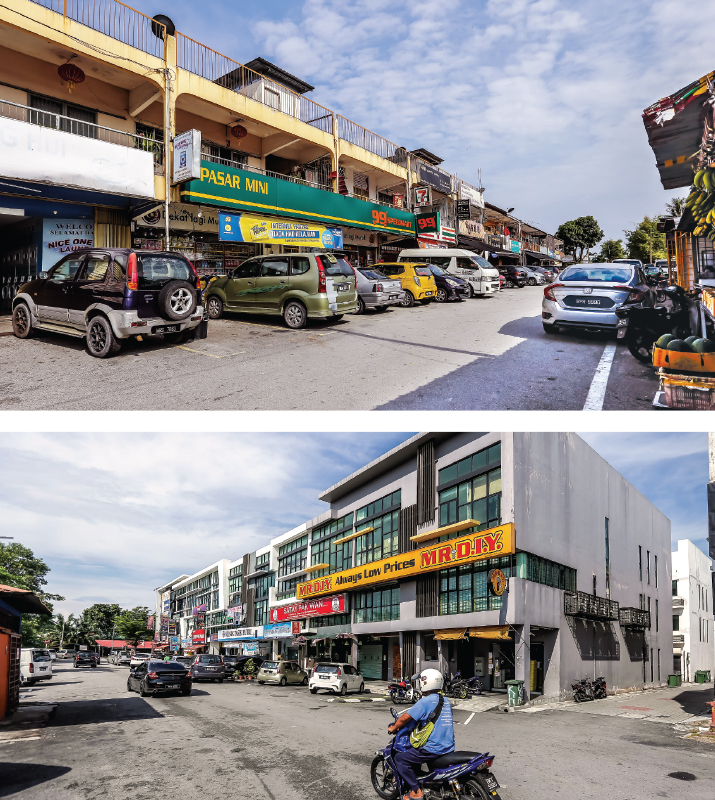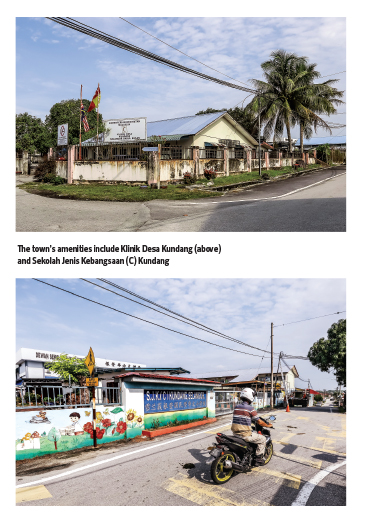
Tasik Biru Seri Kundang is a well-known landmark (Photo by Zahid Izzani/The Edge)
This article first appeared in City & Country, The Edge Malaysia Weekly on July 19, 2021 - July 25, 2021
Kundang has changed a lot since I visited the town in 2014. Back then, there were many green pastures and the Kundang (Timur) and Kundang (Barat) toll plazas had just been completed and were not yet operational.
It is believed that the town got its name from the nearby Kundang River. Buah Kundang is the Malay name for plum mango.
Located in the northwestern part of the Klang Valley, Kundang comes under the jurisdiction of Majlis Perbandaran Selayang. Neighbouring towns include Sungai Buloh and Bandar Puncak Alam.
Historically, mining and agriculture were the main activities in Kundang. Mining companies opened up the area in the early 20th century and the largest mining operator in town was the British-owned Kundang Tin company. Many Chinese immigrants arrived because of the mining activities, says PPC International Sdn Bhd managing director Datuk Siders Sittampalam.
Humble beginnings
A railway track was built in 1915 to connect Kundang to Kuang and Batu Arang. The railway track was demolished 55 years later.
The residents of the town were mainly involved in agricultural activities and planted rubber trees and, later, papaya trees.
“In the 1990s, the villagers started to leave the papaya plantations due to the low pricing and profitability. Gradually, small, landed residential schemes with 2-storey terraced houses began to emerge,” Siders tells City & Country.
Kundang has remained quiet since, as it does not have many attractions or landmarks. The most famous landmark there is Tasik Biru Seri Kundang, an abandoned mining pool and a remnant of the town’s past glory.
The town has a limited number of amenities, including Sekolah Jenis Kebangsaan (C) Kundang, the Kundang Police Station, Dewan Komuniti Kundang Botanic and Surau Al-Mardhiah. Beyond the town, one can access nearby amenities such as Aeon Rawang, Mydin Rawang, Giant Rawang, Sungai Buloh Hospital and KPJ Rawang Specialist Hospital.
However, the Kundang landscape has seen a transformation over the past few years, with a number of property players launching projects there. They include Low Yat Group (Bandar Tasik Puteri), Gamuda Land (Kundang Estates), PPC Chye Hin Group (Nido Gardens), OIB unit Myra (Myra Gardens), Scientex Bhd (Scientex Kundang Jaya), SMD Development Sdn Bhd (Kundang Jaya Industrial Park) and Tan & Tan Developments Bhd (D’Laman Kundang).
Challenges
The residential developments in Kundang have seen slower growth compared with other areas in the Klang Valley. Property consultants cite the lack of accessibility as one of the reasons.
Before the completion of the Kuala Lumpur-Kuala Selangor Expressway (Latar Expressway) in 2011, Kundang could only be accessed via old, narrow and poorly maintained roads. Thus, the town was always viewed as more of a village with pockets of planned housing schemes.
According to Rahim & Co International Sdn Bhd director of research Sulaiman Saheh, interest in Kundang has increased in recent years with improved connectivity via the Latar Expressway, which connects to the Guthrie Corridor Expressway and New Klang Valley Expressway.
“The upcoming West Coast Expressway will also be accessible via the Latar Expressway through the Jalan Kuala Selangor exit. The increased accessibility coupled with the growing urbanisation in the northwestern part of the Klang Valley, the serene surroundings, and the more affordable houses are keys to growth in the area,” he tells City & Country.
Siders points out that the overall trend of development in recent decades — towards the southern part of the Klang Valley, due to Putrajaya and the Kuala Lumpur International Airport, rather than to the north — has played a role in the slower growth of Kundang.
Meanwhile, in the north, Sungai Buloh has become the choice area for development, with the redevelopment of the former 2,200-acre Rubber Research Institute land, which is now known as Kwasa Damansara.
In recent years, Kundang has seen modern residential developments. Property consultants expect the town to be further developed, but more catalysts — such as major residential developments and amenities — are needed.
Sulaiman reckons that Kundang will be able to attract buyers looking for landed homes with an affordable price tag as it offers newer alternatives compared with the neighbouring towns.
“Kundang was less developed in terms of its infrastructure compared with [the nearby] Rawang and Sungai Buloh. These two areas saw major residential developments first, being catalysts for the growing townships, especially with the suburbanisation trend pushing growth in the outskirts of Kuala Lumpur and the Klang Valley metropolitan area,” he says.
“The industrial segment is also seeing some new developments, attracting those looking for small and mid-sized properties. But these were not sufficient to spur more progressive residential growth such as that seen in Rawang, Bukit Rahman Putra and Sungai Buloh.”
A challenge facing Kundang now is the lack of control over industrial-related emissions and environmental management in some areas there, says Sulaiman. Residential spots have grown organically closer to some industrial areas, causing unfavourable living conditions.
“The local authority has revised the local plan and due processes involved in zoning change applications to improve the management of the area. This includes a programme that addresses ad hoc and illegal industrial facilities, rezoning process improvements as well as the provision of sufficient public amenities and facilities to cope with future demand,” he says.
Upcoming developments
The lack of available land and rising land cost in nearby areas have helped increase the demand for properties in Kundang, which now has several ongoing and upcoming major residential developments, bringing different groups of buyers into the area.
Siders notes that the buyers in Kundang are mostly owner-occupiers from the lower-middle- to middle-income groups. “The newer residential schemes comprise mainly terraced houses occupied by younger families and upgraders from the village. Meanwhile, the older residential dwellings are occupied by lower- to middle-income earners,” he says.
Over the years, property prices have gradually increased in Kundang. Sulaiman says that 2-storey terraced houses have seen a compound annual growth rate of 1.5% to 12%, or an average of 4.7%, depending on the project.
“Looking at the price trends more closely, the growth was more pronounced in the years before 2017/18, after which prices were more stagnant, in line with the general trend in the market due to the challenging market conditions. However, the area is expected to grow further in the long run as the demand is predominantly local buyers and owner-occupiers,” he says.
He attributes the uptrend to the newer developments with comprehensive offerings, contemporary design features and facilities. Nevertheless, he warns that the sustainability and market acceptance of the newer price benchmarks will depend on the take-up and actual occupation of the units sold.
Future prospects
Property consultants are optimistic about the prospects of Kundang, due to the improved accessibility provided by highways and the growing saturation levels in the neighbouring areas — especially with the demand for landed homes.
As with any new development, the vibrancy will depend on the planning for the area, Sulaiman points out. “The right mix of amenities — as well as careful planning when balancing between pre-existing commercial activities and industrial spots in Kundang — is important to ensure residential spots are not negatively affected by their surroundings. This includes the maintenance of public infrastructure such as good quality roads, as there will be more traffic when there are more residents,” he says.
Save by subscribing to us for your print and/or digital copy.
P/S: The Edge is also available on Apple's App Store and Android's Google Play.
- How much does Malaysia trade with the US?
- Nvidia says new limits on China exports to cost US$5.5 bil
- US tariffs may cost chip equipment makers more than US$1 bil, industry estimates
- Malaysian banks, despite local focus, will suffer from trade tensions fallout — TA Securities
- Gold climbs to record as expanding trade war aids haven demand
- Selangor govt denies offering rental houses in remote areas to Putra Heights fire victims
- Defence tech startups’ next target: captainless, AI-powered navy ships
- Chinese President Xi accorded state welcome at Istana Negara
- Kaspersky reports a 153% rise in ransomware attacks on Malaysian businesses in 2024
- China's Xpeng says it reviewed supply chain to insulate it from tariff turmoil





